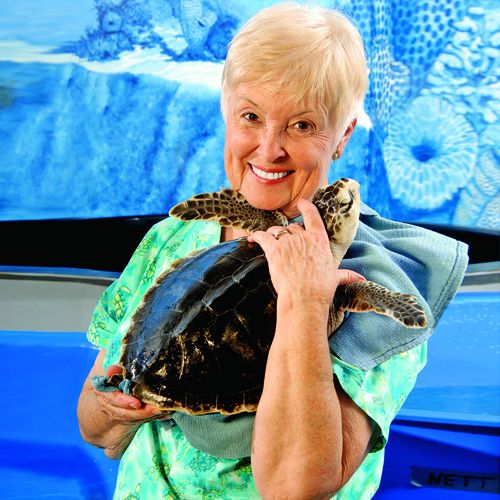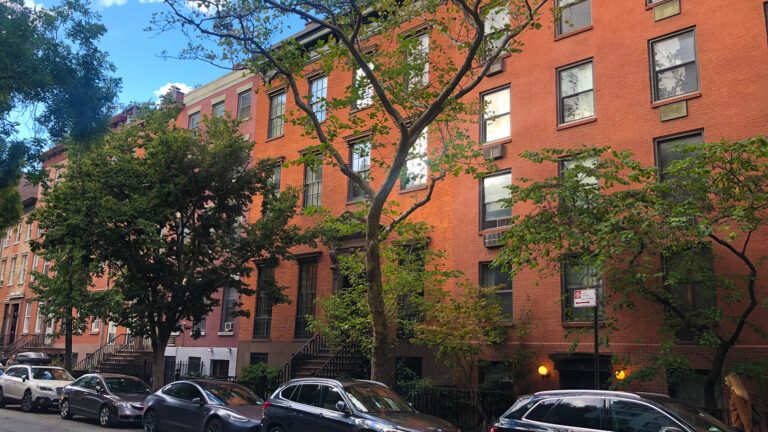My brother, Richard, saw it first. “Jean!” he shouted, running up toward our little vacation beach house. “There’s something huge coming out of the ocean!” The moon wasn’t quite full that summer night on Topsail Island back in 1970. But it was pretty close.
My husband, Fred, and I had fallen in love with the beaches of Topsail back in 1970, on our honeymoon. We’d vacationed there ever since, and had recently bought this beach house. I squinted down toward the waves. An animal the size of a truck engine was making its way up the beach, right for our house.
It was past midnight, but I ran inside and woke up the kids. We all gathered on the deck.
“What is it, Mom?” Karen asked. Eight that summer, she was my youngest and every bit the nature lover I’d been at that age.
“It’s a turtle,” I said. “A sea turtle.” I’d seen the posters put up by the National Marine Fisheries Service. Sea turtles were a threatened species. The females lumbered ashore to lay their eggs.
She came to a halt right at our porch steps and began digging with her back flippers. Sand flew through the air, smacking against the porch. One by one the family got enough of the spectacle and headed back to bed.
Not Karen and me. Wrapped in blankets, we watched until 2 a.m., when the turtle finally finished her task and crawled back into the thundering waves.
Early the next morning Karen and I were down in the sand, examining the spot where we knew the eggs were buried. “How long do you think it’ll take them to hatch, Mom?”
“Let’s find out,” I said.
We called the North Carolina Wildlife Resources Commission, but they had no record of turtles nesting on Topsail Island. Finally, we found a government pamphlet that gave us some answers. What we’d seen was a loggerhead—one of seven species of sea turtles, all of which were either endangered or threatened.
Sea turtles live their entire lives in the ocean, except for when the females, traveling hundreds, or even thousands of miles, somehow return to the exact beaches where they hatched decades earlier to lay eggs of their own.
Female loggerheads laid several nests, coming back to shore repeatedly over the course of a few weeks. Karen and I walked up and down the beach, looking for trenches in the sand like the one our turtle had made (they’re so big that people sometimes mistake them for bulldozer tracks).
We found a bunch, but we’d learned that as little as one turtle in 10,000 makes it to adulthood.
Nests take about 60 days to hatch. Karen and I were back home in Ohio by the time the babies in “our” nest saw the light of day. The first thing we did when we returned the next year was check on it. There wasn’t much left to see—just the vaguest indentation in the sand where we knew it had been.
How many babies had made it down to the water?
“I wish we could have been here to help, Mom,” Karen said, a little sad. So did I.
Summer by summer we learned more about the turtles—and about how to help them. We swept over the trenches left by mothers so their nests would be undisturbed. When hatching time came we dug roads in the sand that the babies could follow down to the surf.
Sometimes we found stragglers from a nighttime hatching. We’d put them into the water and say a prayer for them as they winged their way toward deeper water. We kept track of the nests we found and reported them to wildlife officials.
Word spread about this strange mother-daughter turtle-finding team. We got calls about injured turtles that washed up on Topsail’s 26 miles of beach.
Fishing nets and speedboats can be a menace to them. Turtles hit by propellers were one of the most common victims on Topsail’s beaches. There was little that Karen and I could do for these animals.
Not that Karen didn’t have things in her life besides turtles. In 1990—the same year that Fred retired and we moved to Topsail permanently—she graduated from college and got a position with a Charlotte public relations firm.
We were incredibly proud of her—what mother wouldn’t be? And probably more excited about her new life than she was.
But then something terrible happened. Like so many terrible things it started out small…just a nagging cough. It wouldn’t stop nagging her. Karen saw our family doctor. She had leukemia.
“The more rest she gets,” the doctor said, “the better chance she has.” Karen gave up her dream job and moved back into the beach house with Fred and me.
Orders to rest or not, Karen stayed busy. It was the height of the nesting season. Mother turtles were laying eggs up and down the beach.
“That’s the third call we’ve got this morning about the same turtle nest,” Karen said one morning, exasperated. “Mom, we need to get this thing more organized.”
So the Topsail Island Turtle Project was officially born. Karen lectured at schools and libraries, explaining the vital role that sea turtles play in the ocean’s ecosystem. Turtles are a bellwether species. Their disappearance means more than just no more turtles. It means our oceans are dying.
How, Karen asked, could we sit back and let these animals slip into nonexistence before our eyes?
Extinction is a big word. Most of us don’t want to think about what it means. Extinction is a full stop. There’s no coming back. It’s permanent, irreversible. It takes courage to imagine something that large—that terrible. But Karen had that courage.
She knew what it meant to face up to endings, even if I was still struggling to accept her worsening illness.
“Mom,” she said to me one day as we were looking out the kitchen window at the late autumn light, “you know they signed me up for a life-insurance policy when I was working. I don’t want my illness to be the center of my life. I want the turtles to be the center of it. If I don’t make it, I want you to use that money for them.”
If I don’t make it… The words hung in the air. Karen and I didn’t talk about death. It was too painful for me. But she cared too much about the turtles to risk my not knowing her wishes.
“Okay, Karen,” I said. “I promise.”
Late one evening in 1991 Karen and I got a phone call that a big female had come ashore a few miles down the beach from us. Karen’s illness had been running her hard of late—harder than usual—but she refused to let her disease get in the way of helping those turtles.
So we got into the car and drove down to the spot where the caller had indicated.
The telltale furrow in the sand was easy to see in the moonlight. Karen and I found a spot close enough to the nesting turtle to keep an eye on it, but far enough away that we wouldn’t disturb it. Next to the moment when the newly hatched turtles make their mad dash to the waves, nesting can be the most dangerous moment in Mama turtle’s life.
But not with Karen around. “Do you want to go home and get some rest, Karen?” I realized how foolish the question was before it was out of my mouth.
“Don’t worry, Mom. I’ll get some rest later. As soon as she’s safe.” It was 2 a.m. before the turtle had laid the last of her eggs and slipped back into the sea. Karen went home and slept in. The next day, she felt too ill to go out. No, God, no, I prayed. I’m not ready to lose Karen.
Two days later, Karen slipped away peacefully, just a few months before her thirtieth birthday.
I plunged into helping the turtles with more energy than ever, channeling a grief that seemed too much for me to bear. Karen was gone—at least from the earth. But her work on behalf of the earthly creatures she cared for most went on.
In 1995, four years after Karen’s death, a 40-pound immature loggerhead turtle washed up on the beach at North Topsail Island with severe injuries, most likely caused by a boat propeller. Greg Lewbart, a doctor at North Carolina State University College of Veterinary Medicine, agreed to look at him.
“This turtle is lucky you found him when you did,” Dr. Lewbart told me. “He’s also lucky that his braincase wasn’t broken or his optic nerve severed by the propeller that hit him.”
I decided to call him Lucky.
We fixed Lucky up with a discarded fiberglass tank, and he ended up spending 18 months with us. When his wounds were finally healed, some Topsail Island Turtle Project volunteers and I carried him down to the sea. “So long, Lucky,” I said, as he slowly flapped out to sea. “May the Lord watch over you.”
I had seen plenty of turtles by then, but only in passing. Lucky was the first Topsail sea turtle I really got to know personally. There’s something uniquely painful and uniquely rewarding about taking in a wild creature, caring for it, coming to know it as an individual and setting it free again.
You put so much love and worry into the animal…and then you place it right back in harm’s way.
Of course, that’s what every parent does as well. No one knew that better than I did.
In the days after Lucky left us, I couldn’t get Karen’s words out of my mind. Help the turtles. To really help them I needed—the turtles needed—a turtle hospital. The Karen Beasley Sea Turtle Rescue and Rehabilitation Center opened its doors in the fall of 1997.
Since then we’ve rehabilitated and released more than 150 sick and injured sea turtles. Some stay with us for just a few days. Others spend months, even years here. But for all of these animals, there eventually comes a moment when I have to tell them goodbye. When I have to give them back to the ocean, and back to God.
It’s never easy. But there’s no time that I feel closer to God—or to Karen—than when I place one of these turtles in the waves and watch it swim off to make its ancient way in the world.
Sea turtles are just one of the world’s many endangered species. But they’re my species—the one I’ve dedicated my heart and my life to helping, just like Karen did.
By chance or, perhaps, by something more, a mother turtle picked my daughter and me out on that moonlit summer night so many years ago, when she crawled out of the sea, right up to our doorstep on Topsail Island. Yes, God does have a way of getting your attention.



